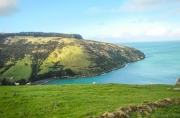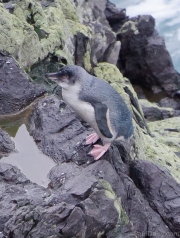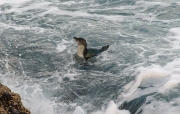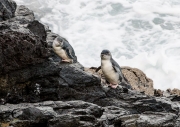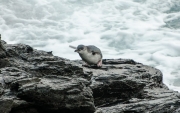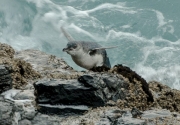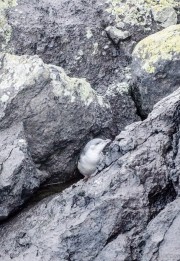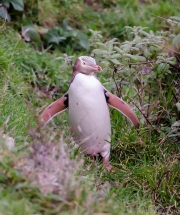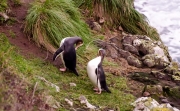If you are interested in seeing unique wildlife and scenery while you are in Christchurch, seeing blue penguins in the wild should probably be at the top of your list. There are quite a few resources on the web on where such opportunities exist, most being in Oamaru and Dunedin. On the Bushy Beach near Oamaru people can see penguins coming out on land in the evening. If you are in the Dunedin area it seems like there are quite a few options available to you, such as Pukekura and Sandfly Bay. But Oamaru is over 3 hours away from Christchurch by car, and Dunedin is 4.5 hours away. If you are in Christchurch and have only a day to see the penguins, there is Pohatu Penguins in Akaroa, which is only a 1.5 hour drive away, with relaxed driving and beautiful scenery along the way. I left at about 8:30 AM and stopped at the Blue Duck cafe for a nice breakfast of eggs Benedict and a tasty cup of coffee.
The penguin reserve is located on the Flea Bay, a short but steep drive away from Akaroa. You would have to book a tour, since uncontrolled public access to the nesting area is not allowed and the guides will want you to strictly abide by the rules so that the birds are not disturbed. The blue penguins (or, rather, the white-flippered penguins, which are the Pohatu sub-species of blue penguins) are very shy and start getting nervous when they see people approaching closer than about 50-60 m, particularly if they see people silhouetted against the sky.
I visited in the winter, in July, and it rained off and on. July is a slow season for seeing the penguins, but when I called I was told that viewing is actually fairly good, and the penguins come out of the water still in daylight. I immediately signed up, and, being the only customer, received individual treatment with a tour that started off regular hours, optimized for the evening viewing of the birds.
One word of advice: wear good footwear. Traction is of number one importance: the wet dirt trails you have to walk, especially those leading to the better viewing areas, branch out along the shore, skirting a steep slope, and there are no handrails along the trails. If you fall in some areas you will likely slide on the grassy slope for the first 50 feet and then drop straight down for the last 20, landing on the rocks or, if you are lucky, into the water. I would recommend sturdy hiking boots with aggressive tread. A monopod that could be used as a staff will not hurt either.
Your guide will pick you up in Akaroa and drive over to the Flea Bay. The single track road was winding and narrow, covered with shale gravel. Following a series of switchbacks we reached the rim of the Akaroa crater, where we stopped to look around and take some pictures. The crater is large and very old, severely eroded and leveled over the last 9 million years, and from the 700 m height of the rim you can see all the inner bays and peninsulas.
One the South side of the rim the road winds down a series of switchbacks, with cows and sheep grazing everywhere on the slopes by the side of the road. A variety of birds can be seen, with large hawks and seabirds particularly striking. Stunning views of Flea Bay will open before you, with the dark sandy beach deep in the bay and ragged rocky shores all along its sides. If you pause and look closely you can see groups of penguins floating on the water in the middle of the bay, but from this far away they look like specks on the glimmering turquoise bay waters.
After you don a camo cloak upon arrival at the Pohatu Lodge your guide and the owner Shireen will take you for a walk on the Eastern side of the bay. Along the way there are a number of small nesting sites, which look like tiny doghouses. These are penguin nests. We lifted the roof on one of them, to see two 30-cm long blue penguins hiding in there, looking incredulously at us as if asking, what is going on? how come all of a sudden our roof is gone? We closed it after a brief glance and quietly moved on.
A few hundred meters along the trail you rise up over the shoreline and look at it from about 50 m height. Down on the rocks there were two seals sunning and dozing, although the smaller female caught the sight of us and tracked us in the unusual seal way, bending her neck back to look at us over her back with nose up in the air. We had to have looked upside down to her but she must be used to that.
There were several groups of penguins on the water, 200-300 m from shore. They float there after feeding in the ocean all day, resting, and come to shore later when the sun begins to set. We moved on and walked along the precarious wet trails, with Shireen and Kevin, the guide, moving effortlessly and me lumbering behind, minding my footing in my city slicker shoes. I knew that falling is only a matter of time, and tried not to fall at least in particularly steep sections.
We have reached a turn in the shoreline when Shireen stopped and pointed out to a rock outcropping ahead and below us, where a single blue penguin hunched over, shaking periodically like a wet cat from all the spray that fell on him from the white foamy breaking waves below. The bird was only a few feet from the water, but instead of moving a few more feet he just sat there, getting doused every time a wave hit. A few other penguins appeared to be interested in coming ashore in the same area, so we stayed and watched them battle the surf to come out on a slanted ragged rock and scurry away from the waves slamming into them. It takes the penguins several attempts to line up on the approach but eventually they do. Once they gain solid footing they seem to relax and think they are safe. This is when the next wave pours over them, and I saw one of the birds being washed back into the ocean like that. Displeased, the penguin paddled back to shore and climbed back onto the rock, and again sat in the same spot he was washed off of a second ago. Eventually he moved off a little deeper onto the rocks, where only the spray would reach him.
We spent over an hour watching the little blue penguins, with about 7 of them eventually landing on the same outcropping where the first one originally was sitting. It was getting darker, and we decided to start walking back towards the area where yellow-eyed penguins were known to rest at night. As we walked we heard a call that Kevin recognized ad the yellow-eyed penguin, and it came from close by. We hurried to the hide (a blind), from where that area of the shore was visible, and that was where I lost my guard and finally fell. Fortunately it was not on the slope and I was able to catch the camera, preventing most of the damage.
The yellow-eyed penguin was already high up on the shore, and he walked within 40 feet of our blind. He stood there in the fading light of the day, wings spread, looked around and occasionally made the call that we had heard earlier. Eventually, two more penguins came ashore below us and started their grooming ritual, spreading the oil from their tail glands over their bodies, straightening the feathers and overall making sure they look properly dignified. It was getting dark quickly now but I still was photographing away, hoping that a few pictures would come out.
In near darkness we returned to the van. Sore from my fall but happy and full of amazing memories, I thanked Shireen and Kevin and we departed the Flea Bay. It started raining, changing to snow at the higher elevation, but we reached Akaroa without problems. I limped to a restaurant, the only one open in the evening off tourist season, and after a nice meal unhurriedly drove back to Christchurch, re-living all of my memories of the day as I watched kilometers go by. Thank you, Akaroa, thank you Pohatu Penguins, and thank you, the little blue ones. It was unforgettable.

